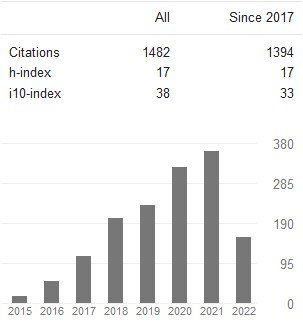Monocyte chemoattractant protein-1 and cyclooxygenase enzymes in rats treated with drugs of abuse
DOI:
https://doi.org/10.56511/JIPBS.2024.11202Abstract
The CC chemokine monocyte chemoattractant protein (MCP)-1/CCL2 and cyclo-oxygenase-2 enzyme are potent mediators of neuroinflammation. We studied the effect of treatment with Cannabis sativa resin extract and/or tramadol, two common drugs of abuse on the level of MCP-1 in brain and serum of rats. In addition, serum levels of cyclo-oxygenase 1 (COX-1) and cyclo-oxygenase 2 (COX-2) enzymes in rats given cannabis were also determined. Cannabis sativa resin at 5, 10 or 20 mg/kg (expressed as delta-9-tetrahydrocannabinol), tramadol at 5, 10 or 20 mg/kg or tramadol at 10 mg/kg combined with cannabis at 5-20 mg/kg were given once a day, subcutaneously, for six weeks. Results showed that, as compared to corresponding controls, Cannabis sativa resin produced a significant increase in MCP-1 increased in brain tissue (29.8-56.4%) and serum (14.8-31.0%). MCP-1 showed also significant increments in brain (34.6%) and serum (22.1%) by 20 mg/kg tramadol. After the concomitant treatment with both cannabis and tramadol, MCP-1 increased in brain by 88.5-145.7% and in serum by 32.6-64.8%. Moreover, cannabis given at 20 mg/kg significantly increased serum COX-1 and COX-2 by 362% and 58.8% compared to corresponding control values. The histopathological study of the striatum of cannabis-treated animals revealed the presence of apoptotic cells and pyknotic nuclei and congestion of blood vessels. The striatum from animals given tramadol showed neuronal perinuclear cytoplasmic vacuolations and apoptotic cells. Moreover, the combined administration of both cannabis and tramadol resulted in neuronal necrosis, vacuolation, apoptosis and pyknosis. Collectively, these results indicate that treatment with cannabis resin and/or tramadol is associated with a proinflammatory response that involves MCP-1 and cyclooxygenases and which could result in the development of brain injury.
Keywords:
Tramadol, cannabis, addiction, monocyte chemoattractant protein, cyclooxygenaseDownloads
Published
How to Cite
Issue
Section

This work is licensed under a Creative Commons Attribution-NonCommercial-ShareAlike 4.0 International License.



 Journal of Innovations in Pharmaceutical and Biological Sciences is licensed under a Creative Commons Attribution-NonCommercial-ShareAlike 4.0 International License. Based on a work at
Journal of Innovations in Pharmaceutical and Biological Sciences is licensed under a Creative Commons Attribution-NonCommercial-ShareAlike 4.0 International License. Based on a work at